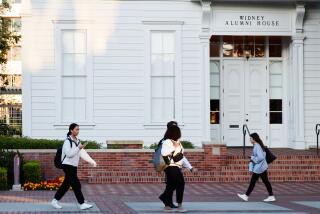Muslims Seek Removal of Courtroom Carving
- Share via
As many as a dozen U.S. Muslim organizations have quietly asked the U.S. Supreme Court to remove from its courtroom wall a carved stone depiction of a sword-wielding Muhammad, Islam’s revered prophet.
While saying they appreciate that Muhammad is honored by inclusion in the court’s pantheon of 18 prominent lawgivers of history, Muslims note that Islam discourages its followers from portraying its prophet in paintings, sculptures or other artistic representations, and do not like it when non-Muslims do.
Moreover, the 7th-century religious leader is portrayed not only with the Koran--Islam’s sacred scriptures--in one hand but a sword in the other.
“This imagery reflects long-held stereotypes of Muslims as intolerant conquerors and perpetuates misconceptions that continue to have a negative impact on the lives of ordinary American Muslims,” said a joint statement given to Supreme Court administrators Monday by the Council on American-Islamic Relations, based in Washington.
Not all U.S. Muslim leaders, however, believe the stone depiction should be removed.
Islamic cultures have tolerated artistic depictions of Muhammad in Turkish and Persian art, said a statement issued Saturday by the Muslim Women Lawyers for Human Rights, based in Richmond, Va.
Furthermore, the lawyers’ group said, “swords are repeatedly used as a symbol for the protection of law and justice” in the Supreme Court’s other bas-relief depictions and exterior sculpture. “We do not believe it is necessary to destroy” the stone carving of Muhammad, the statement said.
The bas-relief stone carvings of lawgivers such as Moses, Solomon, Confucius, Charlemagne and others have been on the interior walls of the room where the court has held public sessions since 1933.
But Ibrahim Hooper, a spokesman for the Council on American-Islamic Relations, one of many advocacy groups for the nation’s estimated 3 million to 6 million Muslims, said his organization only became aware of the depiction of Muhammad in December.
“Our council is less than 3 years old,” Hooper said. “The American Muslim community has only in the last few decades grown large enough and sophisticated enough to make its presence known.”
Muslim leaders presented their viewpoints in January meetings with James C. Duff, administrative assistant to the chief justice, and Gail Galloway, curator of the Supreme Court.
Hooper emphasized that the council and other Islamic representatives had attempted to negotiate changes behind the scenes without making their protest public, until The Times inquired Friday on their appeal to court officials.
The Minaret magazine, a Los Angeles-based monthly circulated nationally, published a story in its current issue on the bas-relief and the growing Muslim objections to it. Minaret Editor Aslam Abdullah of Los Angeles also wrote a story on the protest for the newspaper Pakistan Link, thus stirring objections in that country and the Middle East, he said.
Abdullah suggested in his Minaret article that an appropriate response by the Supreme Court would be “to remove the picture with the sword and the Quran [Koran] and replace it with a Quranic verse emphasizing law and justice.”
Muslim activist Salam Al-Marayati, director of the Los Angeles-based Muslim Public Affairs Council, one of the groups that signed the protest statement, said discovery of Muhammad’s portrayal in the nation’s highest court produced mixed responses.
“There is an appreciation for the positive reinforcement that Muhammad and other prophets of God--David, Solomon and Moses--are included among history’s greatest lawgivers,” said Al-Marayati, who lives in Glendale. “But Muslims are sensitive about created images of God’s prophets--and showing a sword hits a raw nerve.”
That point was echoed by Dr. Maher Hathout, ex-president of the Interreligious Council of Southern California and longtime spokesman for the Islamic Center of Southern California. “Even a well-meant portrayal of the messenger of God with a sword in his hand may unwittingly feed this stereotype” of Islam “as a violent faith,” he said.
Nonetheless, in Virginia, Azizah Al-Hibri, a University of Richmond law professor who is executive director of the Muslim women lawyers’ group, said Saturday that the longtime inclusion of Muhammad among the court’s portrayed lawgivers should not necessarily bring calls for its removal. “In reaching our position, we consulted with many Muslim leaders, including those with the American Muslim Council and Taha Jabir al-Alwani, president of the highly respected Fiqh [Islamic jurisprudence] Council in North America,” she said.
U.S. Supreme Court spokeswoman Kathy Arberg said Friday she could not immediately confirm the court contacts with Muslim leaders.
Hooper and Al-Hibri said in separate interviews, however, that Supreme Court administrators responded favorably last week on another point raised by Muslim leaders. The Supreme Court administration said wording on souvenirs and brochures will be changed, including removal of the words “founder of Islam” in describing Muhammad.
“Muslims do not regard the Prophet Muhammad as ‘founder’ but as a messenger who conveyed God’s revelation,” Hooper said.
Islamic tradition says Muhammad, who was born in the Arabian city of Mecca in the year 570, was the final prophet of God in a line extending back to figures in biblical history, including Jesus.
Jesus, not normally regarded by Christians as a lawgiver, is not among the figures portrayed on the Supreme Court wall. The depicted contributors to legal history range from Menes of Egypt, who lived about 3100 BC, to John Marshall, who was Supreme Court chief justice from 1801 to 1835.
More to Read
Sign up for Essential California
The most important California stories and recommendations in your inbox every morning.
You may occasionally receive promotional content from the Los Angeles Times.













